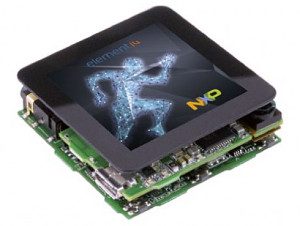The WaRP7 development board is the latest evolution of the “WearAble Reference Platform” (WaRP) development system from NXP Semiconductors – a next-generation, powerful but tiny development platform specifically aimed at the needs of advanced Internet-of-Things products and wearable computing applications.
It provides a complete, powerful ARM Cortex-A7 based embedded computer solution in a tiny form factor, with wireless connectivity, battery power, many different sensors, open-source operating systems and enough flexibility to offer all the advantages of other development tools, and it’s aimed at a range of different IoT applications and markets such as smart home and automation devices, personal devices for fitness and health monitoring and other wearable computing needs.
The WaRP7 platform includes extensive on-board connectivity and peripheral features including Wi-Fi, Bluetooth, NFC, battery charging and power management on board, 8GB of onboard eMMC memory, and support for a huge range of sensors and add-on peripherals.
This system uses the MikroBus expansion socket system introduced by MikroElektronika for their microcontroller prototyping tools, allowing over 200 existing “Click” expansion modules and daughterboards to be added to the WaRP7 for easy development, hacking and rapid prototyping with a huge suite of different sensors and components.
It provides a rapid prototyping platform with pre-validated USB, NFC, Bluetooth, Bluetooth Smart and Wi-Fi connectivity, along with open-source reference OS builds and example software, providing a strong foundation that reduces the time-to-market for your IoT product development and allows product developers to focus their resources on creating their applications and the valuable, differentiating features of their product.
The motherboard is based on NXP’s i.MX 7Solo application processor, the latest in NXP’s (formerly Freescale) widely used, well-proven, Linux-ready i.MX family of processors. This i.MX7Solo system-on-chip features an ARM Cortex-A7 core as well as a Cortex-M4 core on the same chip – with the ability to easily handle both real-time microcontroller and GPIO functions along with higher-level operating systems that provide rich user experiences.
This heterogeneous multi-core architecture provides power management advantages too, allowing the system to drive a higher level operating system but also put the main processor to sleep sometimes, where it can be woken up in low-power modes by the Cortex-M4 processor.
Furthermore, the platform enables the strong energy efficiency that is critical for today’s portable and wearable IoT designs, but also strong computing power and convenient “wake-up” capability from a low-power state when it’s needed.
The platform offers a variety of connectivity and RF communications options, including NFC, 802.11b/g/n Wi-Fi, Bluetooth Classic, Bluetooth 4.1 regular or Bluetooth Low Energy. Storage is covered with 8 GB eMMC for nonvolatile storage and 512 MB LPDDR3 RAM are also provided – along with built-in battery charging and power management, a MPL3115A2 barometric pressure sensor, FXAS21002C 3-axis MEMS gyroscope, and the FXOS8700CQ 3-axis accelerometer plus magnetometer.
A MIPI-DSI display port, built-in MIPI camera on the module and an audio interface are also provided, offering rich multimedia capability, and all these powerful sensors and peripherals are integrated into a tiny main board that measures only 2cm x 4cm.
This platform has been built from the ground up to address key challenges in IoT and wearable-devices engineering, including size, radio connectivity and battery life, and it is provided with a complete open-source hardware and software platform. 
Fully-featured Android and Linux operating system builds are provided, easing development effort for software developers, while also supporting extensive UI capabilities, powerful application software and connectivity stacks. All the source code is provided of course, so you do have the option of modifying the build of the open-source operating system yourself, if you need to customise it.
The WaRP7 development platform could be a powerful new player in the busy development board space, especially in wireless connectivity and wearable IoT applications where more computing power and an operating system such as Linux is required.
With the array of features, the WaRP7 could be the platform for your next Internet of Things product – and we’re ready to help turn your WaRP7 ideas into reality.
Here at the LX Group we have the systems in both hardware and software to make your IoT vision a success. We have end-to-end experience and demonstrated results in the entire process of IoT product development, and we’re ready to help bring your existing or new product ideas to life. Getting started is easy – click here to contact us, telephone 1800 810 124, or just keep in the loop by connecting here.
LX is an award-winning electronics design company based in Sydney, Australia. LX services include full turnkey design, electronics, hardware, software and firmware design. LX specialises in IoT embedded systems and wireless technologies design.
Published by LX Pty Ltd for itself and the LX Group of companies, including LX Design House, LX Solutions and LX Consulting, LX Innovations.



